Abraham Maslow was a highly influential 20th-century American Psychologist. His theories focused on the positive aspects of human nature. Maslow’s key works attempt to understand human motivation. In the mid-1950s he developed his seminal piece, his Hierarchy of Needs. The hierarchy explains how human motivation develops, from basic to advanced needs.
In this blog post, I’ve chosen to reflect on Maslow’s Expanded Hierarchy of Needs. The extra considerations that Maslow makes are important to learning and specifically e-learning. The extended version adds three more layers: Cognitive Needs; Aesthetic Needs; and Transcendence Needs.
The diagram below outlines the Hierarchy, listing the requirements at each level. Maslow did not intend for each level to be complete and satisfied before moving upwards. However, there is an expectation that some of a given level should be met before moving upwards.
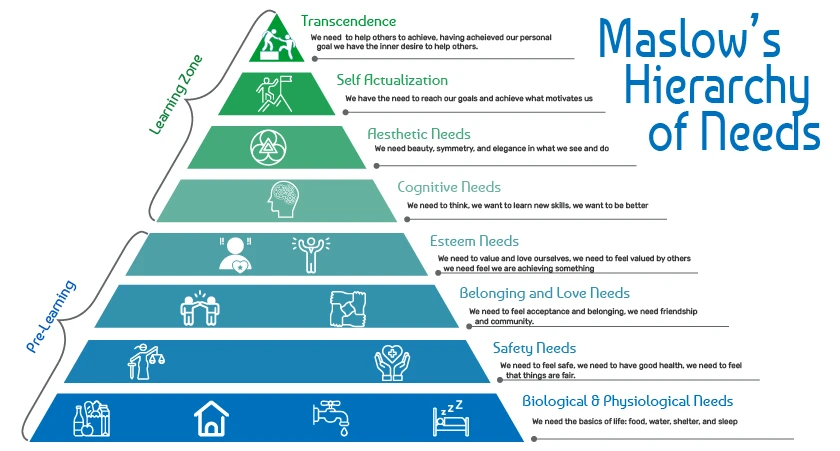
E-Learning and Maslow’s Hierarchy of Needs
Maslow’s Hierarchy is still applied across many disciplines, both academic and professional. Despite this, it rarely seems to be applied within the Learning and Development space. In a traditional PowerPoint knowledge dump, cognitive overload is rarely considered. Unsurprisingly, there is even less attention given to learners’ needs that preceded the cognitive level. Similarly, when e-learning is seen as “applying knowledge”, learners’ needs are rarely taken into account.
Maslow’s Hierarchy of Needs can help us construct effective meaningful e-learning solutions. It does this by putting the learners’ needs at the centre of our planning, execution, and review processes.
Expanding the Base
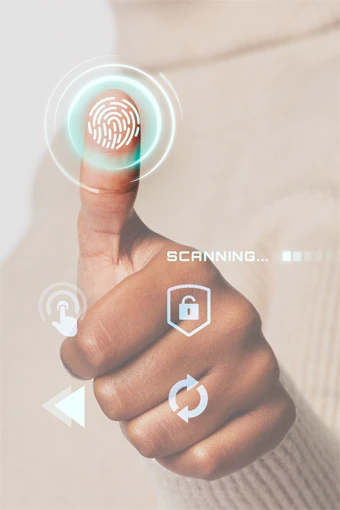
Let’s begin by expanding the biological and physiological needs to reflect our times. In a post-human philosophical approach, technology, environment, and humanity are given equal consideration. They become a trifecta of equality in our understanding and approach. Therefore, we should consider introducing technological consideration to the base level.
Access to the right technology and internet are important for any e-learning course. Using high-end augmented reality is useless if the learner only has a mobile phone. Similarly, restrictive mobile data plans also limit the types of content we can produce. A series of high-definition videos are useless if the learner does not have enough mobile data to watch them.
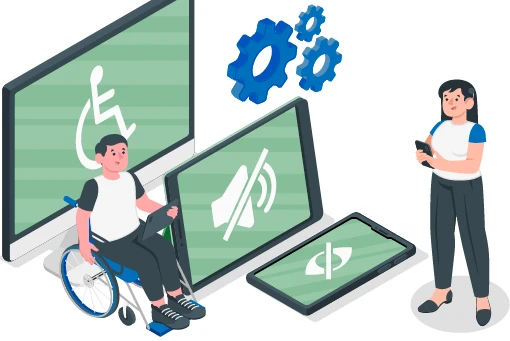
It would be remiss of me to talk of adapting to our modern times, not to mention the place of accessibility. Accessibility is an integral part of the biological and physiological needs of Learners. Accessibility refers to both the physical and the cognitive processes. There is awareness of the physical manifestations, mobility, hearing, and sight. There is often far less consideration for the cognitive limitations that affect many people. In many situations, accessibility measures are either late additions or completely overlooked. This requires a change in thinking to appreciate accessibility and improve usability for all. It requires accessibility standards to be adopted at the planning stage. They need testing at every phase and regularly reviewed to ensure their effectiveness. E-learning is heralded as greatly improving access, availability and convenience to learning. Yet, while accessibility is not at the forefront of what we do, it will not reach its greatest potential.
We need to aim to meet at least some of the Biological, Physiological, and Technological needs at the lowest common denominator. This will help to ensure the basic needs can be met for all Learners.
Safety Needs
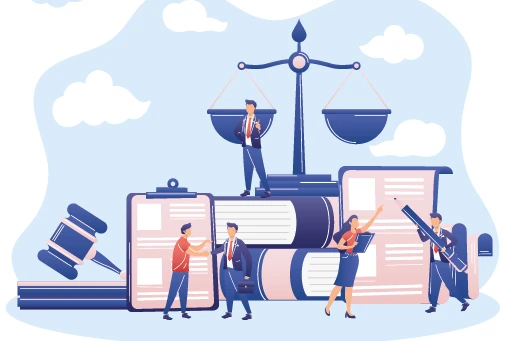
An e-learning experience should assist learners with basic safety needs. We can be open and transparent about the experience. We should explain how the experience works and what the significance of the outcomes will be. Will the data generated will be used and if so by whom, and to what ends? This may include simple things like, this is pass/fail, if you fail “x” will happen. Being open and transparent will help the learner build trust in the experience. Ultimately, we want this to lead the learner to a successful completion of the experience.
I use the word experience here rather than course to improve clarity. Very few e-learning experiences are complete courses, most are often short experiences. Short experiences include things like simple branching scenarios. We should be aiming for clear expectations and transparency in all e-learning experiences.
Belonging and Love Needs
E-learning throws up many challenges surrounding disengagement, disembodiment, and identity. These are an antithesis to Maslow’s “Belonging and love needs”. Many choose to ignore this “can of worms” and move on, but that does little to help the user. There are many examples of badly enacted attempts to create community and belonging. In a recent blog post, I outline my experience of how Coursera failed attempted to address this issue. They’ve created a situation where students’ voices are unheard shouting into an ether. Only an unexplored stream of consciousness remains that has no impact on any learner.
This obviously raises the question. How is it possible to create a sense of belonging within the smallest of e-learning experiences? If you will, a place to get help when a user meets a roadblock in their progression. AI might one day be the solution to help with this problem. Since it has not yet reached the fullness of the Turing Test, it’s safe to say the necessary empathy is a way off too. However, there is still an opportunity within the idea of an assistant avatar. This is something I’ve experimented with a few times, and you can see within two of my portfolio pieces.

Using an avatar assistant allows the learner to find help and support if they’re not sure what they’re doing. It may be as simple as guiding the learner to find the desired outcome. This simple addition can make a difference in supporting the learner. It creates a supportive entity and allows the user not to feel alone. It gives them something to turn to in a moment of ambiguity. How we arrive at the right type of help requires additional planning and forethought. It requires a level of empathy with the learner and their journey through the course. It firstly requires we understand the issues and errors. We then need to create meaningful and suitable responses that can help and support the user.
There is also value in using appropriate imagery to help improve a learner’s sense of belonging. A learner’s sense of belonging is greatly improved when they can see “people like me”. This is achieved by using images that reflect the learners’ profiles. Genuine images can help the brain build a connection and enhance the learning. A genuine picture is required if there is any sense that the image is ‘fake’ or ‘false’ it can have the opposite effect.
Imagery stretches beyond pictures and into words too. As with pictures examples should be relevant to the users’ life experience. Familiar and relatable contexts build connections that improve the learner’s sense of belonging. There is little point in offering an example of car sales negation based upon nursing bedside manner. Even if nurses are extremely persuasive, the example is out of context for the audience. Imagery outside of the learner’s context and lived experience can have a negative impact. The power of images can be a useful tool to engage learners’ sense of belonging with your e-learning projects.
In larger courses, it is not unreasonable to expect stronger community requirements. There are many documented examples of how this can be achieved. We can achieve this by bringing discussions together in a central space. Instant messaging (IM) platforms like Slack, Discord, or WhatsApp, can achieve this asynchronously. Zoom and Teams offer a synchronous approach but may not be ideal for all situations. No matter, the solution there will need to be guidance in discussion. Ideally, from an SME with some additional training. The aim is to help prevent the loudest voices from dominating, and birthing misconceptions.
Esteem Needs
Gamification is often trolleyed out as the solution to motivating and creating self-esteem. The problem with “too much” gamification is that it ultimately defeats its own purpose. Over-collecting shiny things, like certificates for clicking a few buttons, devalues self-esteem. Not everything merits a shiny, not everything merits a certificate. I am reminded of one of my middle school teachers who instilled in us the mantra “You abuse it, you lose it”. It seemingly fits here too, if you over-abuse the rewards, the learner will lose the benefit of them. If you’re interested in ideas on the misuse and abuse of gamification, I’ve written an article on it. So, the message here is that it can be easy to help build esteem in learners. However. we must be careful not to exaggerate and celebrate every button click with a reward. Make it meaningful and make it special. Consider how the misuse of antibiotics has led new viruses to become resistant to them. Similarly, the misuse of gamification can lead to learner resistance to new training. This makes it an uphill struggle to achieve learner self-esteem.

It’s important to make sure that the learner has actually achieved something great. It’s too easy to assume just because someone has passed a course, they now know everything. At times, this flies in the face of scientific theories on knowledge acquisition. Firstly, the learner may already have known the information. Do they need to be rewarded for knowing something already? Does that boost confidence and build self-esteem? It is unlikely. Secondly, if it is new knowledge then the questions are: Are the ideas fully committed into the long-term memory? Will they remember it tomorrow? In a week? In a month? In two years from now? Should we celebrate a short-term memory recall? Or should we celebrate something properly learnt?
Again, there is a balance to be struck between the achievement and reward. Accessing it from short-term memory is a good first step. We shouldn’t allow learners to think that this is the beginning and the end of the learning. It will likely require review, repetition, and application to help it transfer to long-term memory. Building appropriate self-esteem and rewards into this aspect is often overlooked. Yet this is where the real achievement lies. These are things we should seriously consider when creating learning events.
Going Upwards Beyond the Cognitive
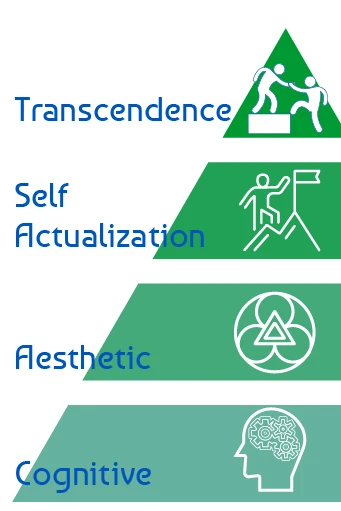
While the aim is to get to the learning zone, we also want our learners to ultimately ascend further upward. We should do this by considering how we aid and support access to the higher levels. Particularly if we want learners to achieve self-actualization and indeed transcendence. It is worth noting the Aesthetic needs that Maslow raises. Again, this is too often overlooked in the rush to get e-learning developed and out there. There is a need to ensure that the production is “aesthetically pleasing”. Aesthetically pleasing means not just elegant and beautiful but also functional. It needs to be intuitive and simple to use, it should be familiar and accessible while being pleasing to the eye. E-learning that does not adhere to aesthetic needs will ultimately be less successful.
More than 50years on, Maslow’s extended Hierarchy of Needs still offers us useful insight in how we can help learners reach their full potential. As Instructional Designers we can apply Maslow’s Hierarchy to the benefit of our students. It can help us make meaningful, and successful learning experiences.